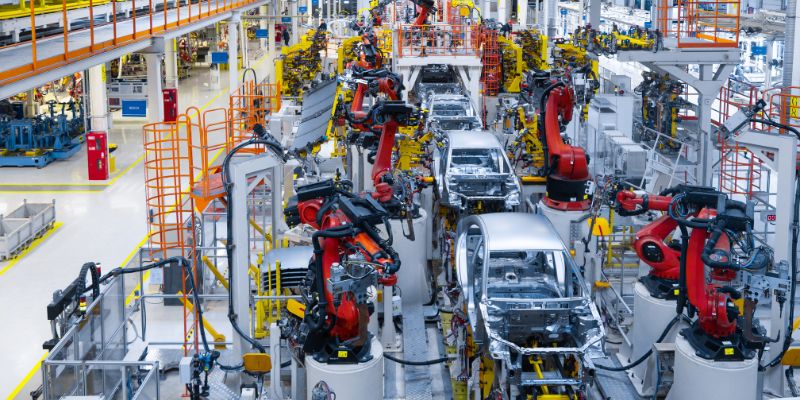What Is an Original Equipment Manufacturer (OEM)? OEM vs. Aftermarket
May 17, 2024 By Susan Kelly
Original Equipment Manufacturer, or OEM, is vital to many businesses, but its importance should be remembered. Everyone in production or supply chain management needs to know what an OEM is and how it works. This article details what OEM means, its main features, and its importance in today's business world.
What Does OEM Mean?
An Original Equipment Manufacturer (OEM) is a business that makes parts or goods used in another business's final product. Usually, these parts are sold to the company that creates and markets the final product, then sold to customers under that companys brand name. OEMs are makers who work behind the scenes and make products used in finished goods.

Characteristics of OEMs:
- Customization: Original Equipment Manufacturers (OEMs) often customize their products to fit the needs of the client business. This ensures that the parts fit together perfectly with the end product.
- Quality Control: OEMs work hard to maintain high-quality standards because any flaws or poor performance in their parts can damage the client companys name.
- Supply Chain Management: Original Equipment Manufacturers (OEMs) manage complicated supply chains to get raw materials, make parts, and get finished goods to customers on time.
- Confidentiality: OEMs work closely with client companies and have strict agreements to keep secret designs, methods, and intellectual property.
OEM vs. Aftermarket
When you compare OEM (Original Equipment Manufacturer) parts to aftermarket parts, you can see a few key changes that may affect your choice:
Quality and Compatibility:
Original Equipment Manufacturer (OEM) parts are made to fit and work with a certain brand or model. They are made to match the exact specs and quality standards of the original tools, so they always work the same way and are reliable. On the other hand, aftermarket parts are made by outside companies and may range in quality, materials, and compatibility. Some aftermarket parts may be as good as OEM parts, but others may need to be better, which could cause problems with fitting or lower performance.
Price:
OEM parts are usually more expensive than aftermarket ones. OEM parts cost more because of the brand name, quality control methods, and warranty coverage offered by the original equipment manufacturer. On the other hand, aftermarket parts are usually less expensive because different makers provide them at different prices. Its important to balance price, quality, and dependability when deciding between OEM and aftermarket parts.
Availability:
Original Equipment Manufacturer (OEM) parts can usually be bought from authorized dealerships or the company that made the equipment. They might only have a few ways to get their products to customers, making older models harder to find in some areas. Aftermarket parts are easier to find and get to through web platforms, specialty stores, and independent retailers. This wider range of options can be helpful when quickly finding replacement parts or for models of tools that are no longer being made.
Warranty and Support:
Original Equipment Manufacturer (OEM) parts often come with warranties and support services from the company that made the equipment. These warranties may cover problems with the goods or the work, giving customers more peace of mind. On the other hand, aftermarket parts may come with limited warranties or warranties from a third party based on the seller or manufacturer. When considering aftermarket parts, its important to look over the guarantee terms and what they cover.
Performance and Reliability:
OEM parts are made to meet the highest standards of quality and dependability. However, some aftermarket parts can work just as well. However, due to the wide range of quality standards in the aftermarket, not all parts may work as well or last as long as OEM parts. Studying, reading reviews, and picking aftermarket brands with good reputations can help reduce quality concerns.
Ultimately, the choice between OEM and aftermarket parts comes down to things like budget, quality standards, availability, warranty coverage, and the needs of the particular equipment. OEM parts may be the best choice for important parts or cases where performance and dependability are essential. On the other hand, aftermarket parts can be used instead of OEM parts when OEM choices are limited, or quality could be more important.

Roles and Responsibilities of OEMs:
- Product Design and Development: During the product design process, OEMs work with client companies to make sure that the parts they make meet the functional, performance, and aesthetic standards that were set.
- Manufacturing and Assembly: Original Equipment Manufacturers (OEMs) use their manufacturing tools and knowledge to make parts quickly and cheaply. This includes cutting, shaping, putting together, and testing the quality.
- Quality Assurance: Strict quality control measures are implemented throughout production to ensure that parts meet industry standards and customer requirements.Logistics and Distribution: Original Equipment Manufacturers (OEMs) handle logistics, such as managing inventory, storing items, and sending them so that client companies can get parts just in time for production.
- After-Sales Support: Some OEMs offer support services for the parts they sell after the sale, such as upkeep, repairs, and warranty services.
Why OEMs are important?
Cost-effectiveness and Efficiency: By outsourcing part production to original equipment manufacturers (OEMs), companies can focus on their core competencies, cut costs, and work more efficiently overall.
Specialized Knowledge: Original tools Manufacturers (OEMs) often have specialized knowledge, technology, and tools that client companies may need access to in-house. This lets client companies use advanced features without having to make significant investments.
Flexibility and Scalability: OEM agreements allow companies to change the amount of production based on market demand, allowing them to respond quickly to changes in the business world.
Global Reach: Many OEMs do business worldwide, giving their clients access to foreign markets and a range of supply chain options that help them grow.
Conclusion:
Original Equipment Manufacturers (OEMs) are significant to the manufacturing ecosystem because they make the complex parts many goods depend on. They are essential partners in modern business because they can customize, keep quality high, handle supply chains, and work closely with client companies. Knowing what OEMs do and how important they are is important for improving supply chain management and building strong business relationships.








